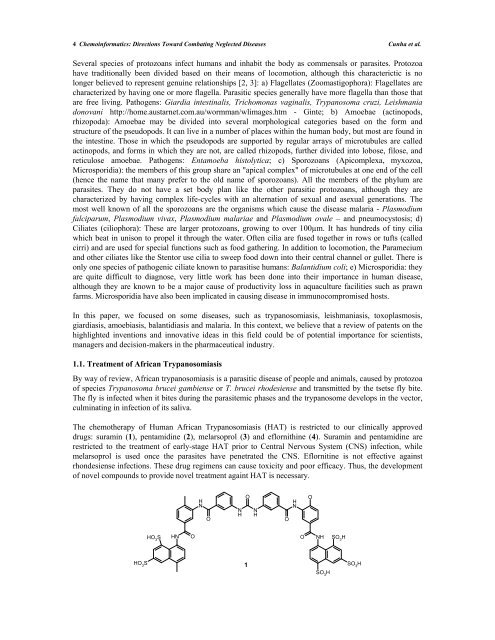chapter 1 - Bentham Science
chapter 1 - Bentham Science
chapter 1 - Bentham Science
Create successful ePaper yourself
Turn your PDF publications into a flip-book with our unique Google optimized e-Paper software.
4 Chemoinformatics: Directions Toward Combating Neglected Diseases Cunha et al.<br />
Several species of protozoans infect humans and inhabit the body as commensals or parasites. Protozoa<br />
have traditionally been divided based on their means of locomotion, although this characterictic is no<br />
longer believed to represent genuine relationships [2, 3]: a) Flagellates (Zoomastigophora): Flagellates are<br />
characterized by having one or more flagella. Parasitic species generally have more flagella than those that<br />
are free living. Pathogens: Giardia intestinalis, Trichomonas vaginalis, Trypanosoma cruzi, Leishmania<br />
donovani http://home.austarnet.com.au/wormman/wlimages.htm - Ginte; b) Amoebae (actinopods,<br />
rhizopoda): Amoebae may be divided into several morphological categories based on the form and<br />
structure of the pseudopods. It can live in a number of places within the human body, but most are found in<br />
the intestine. Those in which the pseudopods are supported by regular arrays of microtubules are called<br />
actinopods, and forms in which they are not, are called rhizopods, further divided into lobose, filose, and<br />
reticulose amoebae. Pathogens: Entamoeba histolytica; c) Sporozoans (Apicomplexa, myxozoa,<br />
Microsporidia): the members of this group share an "apical complex" of microtubules at one end of the cell<br />
(hence the name that many prefer to the old name of sporozoans). All the members of the phylum are<br />
parasites. They do not have a set body plan like the other parasitic protozoans, although they are<br />
characterized by having complex life-cycles with an alternation of sexual and asexual generations. The<br />
most well known of all the sporozoans are the organisms which cause the disease malaria - Plasmodium<br />
falciparum, Plasmodium vivax, Plasmodium malariae and Plasmodium ovale – and pneumocystosis; d)<br />
Ciliates (ciliophora): These are larger protozoans, growing to over 100µm. It has hundreds of tiny cilia<br />
which beat in unison to propel it through the water. Often cilia are fused together in rows or tufts (called<br />
cirri) and are used for special functions such as food gathering. In addition to locomotion, the Paramecium<br />
and other ciliates like the Stentor use cilia to sweep food down into their central channel or gullet. There is<br />
only one species of pathogenic ciliate known to parasitise humans: Balantidium coli; e) Microsporidia: they<br />
are quite difficult to diagnose, very little work has been done into their importance in human disease,<br />
although they are known to be a major cause of productivity loss in aquaculture facilities such as prawn<br />
farms. Microsporidia have also been implicated in causing disease in immunocompromised hosts.<br />
In this paper, we focused on some diseases, such as trypanosomiasis, leishmaniasis, toxoplasmosis,<br />
giardiasis, amoebiasis, balantidiasis and malaria. In this context, we believe that a review of patents on the<br />
highlighted inventions and innovative ideas in this field could be of potential importance for scientists,<br />
managers and decision-makers in the pharmaceutical industry.<br />
1.1. Treatment of African Trypanosomiasis<br />
By way of review, African trypanosomiasis is a parasitic disease of people and animals, caused by protozoa<br />
of species Trypanosoma brucei gambiense or T. brucei rhodesiense and transmitted by the tsetse fly bite.<br />
The fly is infected when it bites during the parasitemic phases and the trypanosome develops in the vector,<br />
culminating in infection of its saliva.<br />
The chemotherapy of Human African Trypanosomiasis (HAT) is restricted to our clinically approved<br />
drugs: suramin (1), pentamidine (2), melarsoprol (3) and eflornithine (4). Suramin and pentamidine are<br />
restricted to the treatment of early-stage HAT prior to Central Nervous System (CNS) infection, while<br />
melarsoprol is used once the parasites have penetrated the CNS. Eflornitine is not effective against<br />
rhondesiense infections. These drug regimens can cause toxicity and poor efficacy. Thus, the development<br />
of novel compounds to provide novel treatment againt HAT is necessary.<br />
HO 3 S<br />
HO 3 S<br />
HN O<br />
H<br />
N<br />
O<br />
N<br />
H<br />
O<br />
1<br />
N<br />
H<br />
O<br />
H<br />
N<br />
O<br />
O NH SO 3 H<br />
SO 3 H<br />
SO 3 H

















